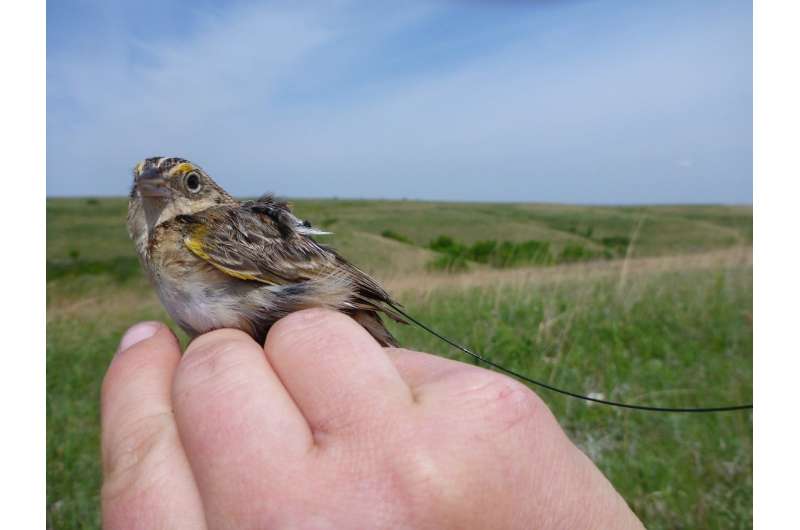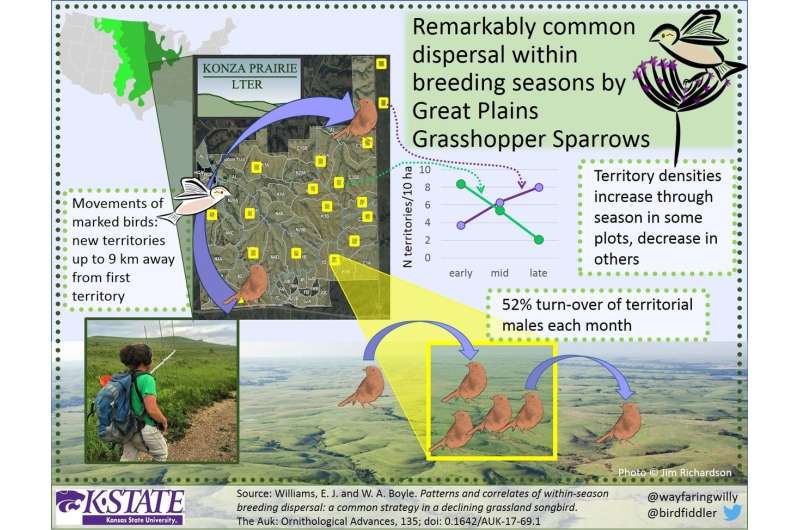Grassland sparrows constantly searching for a nicer home

Some birds regularly move to new territories between years, depending on factors including habitat quality and the presence of predators, but what about within a single breeding season? Grassland ecosystems are particularly dynamic, continuously shaped by fire and grazing, and a new study from The Auk: Ornithological Advances confirms that one particular grassland bird moves frequently each summer in search of the best territories. For Grasshopper Sparrows, the grass really does look greener on the other side.
Emily Williams and Alice Boyle of Kansas State University captured 647 male Grasshopper Sparrows over the course of three breeding seasons and marked them with identifying color bands, surveying territories weekly to track their movements. The results indicate that about 75% of males changed territories at least once per season, with a third of banded defending new territories at least 100 meters away from where they were originally sighted. Additionally, 9 of 19 birds fitted with radio transmitters established new territories as far as 1200 meters away from their original locations.
"We had many plots where the density remained relatively stable over the entire breeding season, which could appear as if individual birds remained settled in the same areas over time. However, what we found was the complete opposite—individuals were blinking in and out of territories the entire time," says Williams, who has since moved on to a position at Denali National Park and Preserve. "So while an onlooker could see a male Grasshopper Sparrow singing on a single patch of ironweed for months at a time, the identity of the individual claiming that ironweed as his own could change two or three times in a single summer." Without careful observations, researchers could completely miss these dynamic movements happening over the course of a season.

This high turnover implies that while some birds might perceive a patch of habitat as no longer suitable, others see the same area as a good place to settle, perhaps because they base decisions on their individual experiences of nest success or failure. High mobility may benefit grassland birds by helping them locate isolated patches of high-quality habitat and colonize newly created or restored habitat, but could also challenge researchers' ability to accurately track survival over time.
"Many avian ecologists have probably anecdotally noticed within-season shifts in breeding territories, yet this is one of the first attempts to actually quantify this phenomenon. The extent to which territorial turnover occurred and the fairly extensive distances moved by males within a season are intriguing!" says the University of Wyoming's Anna Chalfoun, an expert on grassland birds who was not involved in the study. "I am left wondering if this behavior is more common than ornithologists have previously acknowledged and what drives proximate shifts in breeding territories. The results certainly have implications for habitat management for territorial birds of concern and for the accuracy of survival and site fidelity analyses."
More information: "Patterns and correlates of within-season breeding dispersal: A common strategy in a declining grassland songbird" www.bioone.org/doi/full/10.1642/AUK-17-69.1
Provided by American Ornithological Society



















